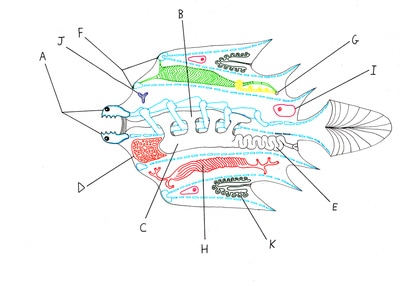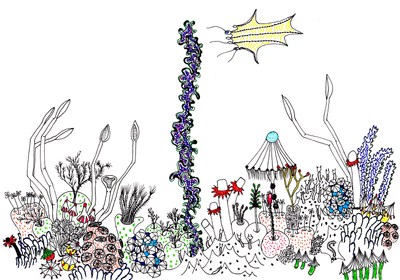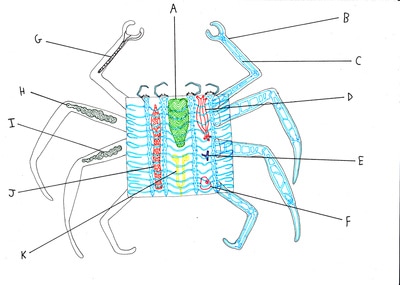|
Legacy by Greg Bear is a book whose story takes place on the planet Lamarckia, named after scientist Jean-Baptiste Lamarck, who is famous for his pre-Darwinian hypothesis of evolution through acquired traits that has since fallen into disfavor. There are only a few dozen genetically distinct organisms on Lamarckia, taking the form of vast forests or other biomes called ecos. Animal-like and plant-like objects are merely parts of the whole that perform their functions. These ecos compete with each other and steal genetic innovations from each other, giving them acquired traits, hence why the planet was named after Lamarck. While the core of the story is the human drama, there is much description of the biology that makes up the setting.
0 Comments
If the life of planet Kaimere looks familiar, that’s because it originally came from Earth, teleported by mysterious means over the eons. Many clades extinct on Earth continue to live on Kaimere. Felids, creodonts, and theropods share the same hunting grounds. Bats, birds, pterosaurs, and strange flying therapsids share the skies.
Keenan Taylor has written an anthology of short stories of the people who live on this world, available at Barnes and Noble. Concept art can be found on his DeviantArt page. Updates can be seen on his YouTube channel. C. M. Koseman, creator of Snaiad, also wrote and illustrated the book All Tomorrows, a future history of the human species. Over millions of years, genetic engineering by both humans and hostile aliens leads to the creation of some truly bizarre monstrosities among our descendants. There are human races that resemble moles, dolphins, flounders, and even colonial siphonophores. A good overview of the book, including some of the art, can be seen at this link.
Nearly all life in the galaxy is descended from the same ancestor through the process of panspermia – and something is trying to kill it. The Sage of Sagittarius by Kenn Brody is a fast read. It is full of scientific details, but without slowing down the action at all. The end is satisfying without being too unrealistic (the “bad guy” is destroyed, but at a heavy cost). Each twist makes sense in the context of the story. The characters are quirky, yet believable, and fairly well developed without getting bogged down in a lot of internal musings – nothing wrong with that, but this book’s focus is on the struggle for survival between species of radically different biology (and physics).
In the course of the story, the characters encounter many alien ecosystems. I liked the mollusk-like beings that sift gold from the sea. I liked the “birds” that planted themselves into the ground and became trees. I liked the centipede-like creatures that kept harems. I loved it. While it doesn’t exactly have the most original plot or most complex characters, the setting of the movie Avatar is really interesting. I enjoyed the special effects and the feeling of immersion in a rich variety of growth. There were glowing plant-things and insect-things. There were also some strange megafauna. My favorite were the flying dinosaur-like beasts. Furthermore, all the trees were connected by some sort of communication system that allowed the entire biosphere of the planet Pandora (actually a moon in orbit around a gas giant) to act as a single brain. This brain physically connected with various animals at various interface nodes. The animals were capable of linking with each other even across species through specialized organs that resemble bundles of fiber-optics. Pandora is definitely a place I wouldn’t mind visiting.
The Future Is Wild is a book (and television miniseries) exploring what life might be like five million, one hundred million, and two hundred million years from now. Squids evolve to walk on land. Fish evolve to fly in air. Slime molds trap and dissolve passing flyers. Corals are replaced by red algae. Jellyfish are huge. Sharks are social. Birds spit fire. The movement of the continents has much to do with natural selection and this is part of the story too.
Wayne Douglas Barlowe is an artist and the author of Expedition, the story of mankind’s visit to planet Darwin 4, home of large, blind, sonar-using liquivores. His paintings of alien plants, animals, and landscapes are amazing. He describes their physiology and behaviors. This is one of my favorite books that I dig out of storage from time to time just to look through. It has inspired me to make my own exobiology art books out of my old doodles, but at the moment I am far too busy.
The trends on Darwin 4 include large size and leg reduction. Some animals have six legs, others four, and others only two. Many have their rear legs fused into one or else have keels to support their weight. Others have their front legs fused into one. The gyrosprinter has both its rear and front legs fused, leaving it with two legs in a row. There are even monopods. Most animals are hermaphrodites, eyeless, rely on sonar, and digest meals outside the body before sucking them up, though there are exceptions to all of these trends. I think my favorites are the tundra creature whose head detaches to become a flying animal while the lower body becomes nothing more than a living shelter, and the groveback – a creature that spends its life sleeping and growing underground while trees cover its back. Barlowe also paints demons, hellscapes, and other awesome things and is available for commissions or licensing. Check out his website. |
Like alien art? Check out my store.
Copyright © 2017



 RSS Feed
RSS Feed